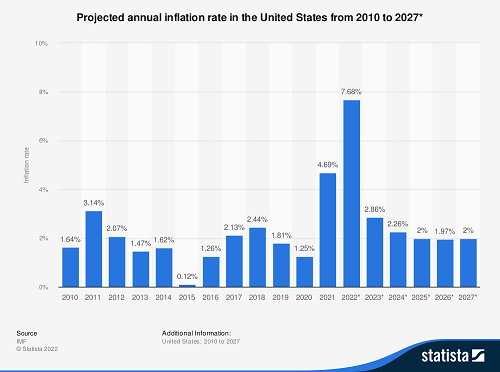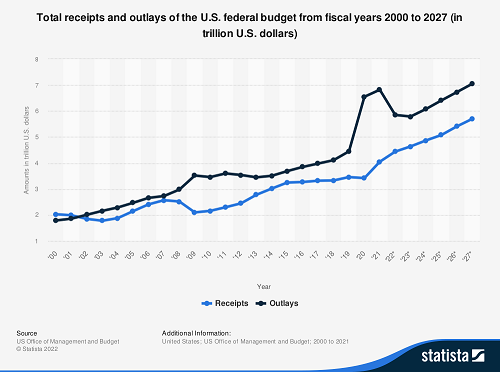Ways to fight inflation
Inflation is making a strong comeback in the United States and consumers are feeling the squeeze. But there are possible ways to combat inflation that will bring down prices in the long run.

Inflation has made a reentry into the American economy after a more than forty-year absence. Consumers are deeply upset, and rightfully so, of higher food prices, paying more for gasoline, and seeing costs escalate at a rate they are not used to. Consumers will either pay more for goods and services, or drastically reduce their consumption. The major retail chain store, Target, is seeing the consequences of consumers cutting back on their purchases when it reported that their inventory is much higher than they want it to be. This trend will more than likely soon affect other retail outlets, whether it is Walmart or Amazon.
However, there are ways that the Federal government can battle inflation and ultimately cause prices to come down to a normal level. It will not happen overnight and there will probably be some bumps in the road, but it is possible if the Federal government is diligent in its efforts to control and bring down inflation in the next year to 18-months.
Federal Reserve Bank must raise interest rates
The Federal Reserve Bank (the Fed) has key objectives in order to ensure the economic health and growth of the United States. First, the Fed is deeply concerned about stimulating sustainable non-inflationary economic growth. The Fed must make sure that the macroeconomy of the United States makes steady, progressive growth over time, which is measured in terms of years. This has helped the American economy maintain its position as the largest in the world while ensuring that most, if not many in the United States, enjoy the highest quality of economic lifestyle in the world. The Fed must make sure that this economic growth does not come at a steep price of out-of-control inflation. Trying to have sustainable economic growth and controlling inflation simultaneously is a difficult task, but the Fed has been able to achieve this objective since the time that Paul Volcker was the chair of the Fed in the early 1980’s.
Secondly, the Fed must make sure that Americans have jobs by keeping employment high and interest rates low as to encourage long-term economic growth. The Fed recognizes the fact that the American economy must be at or near full employment. If this does not occur then long-term economic growth may not be possible. There have been times when there was an economic recession and unemployment rose to approximately 10 percent as seen in the Financial Crisis of 2008-2009. But not to the point of unemployment being 20 to 30 percent as seen in parts of Europe in the past twenty years. The Fed has been able to achieve this objective, while also keeping interest rates at a low level that is the envy of the rest of the world. This has also been very difficult to achieve, but the Fed has been able to do it without financial chicanery.
Given the economic situation that now exists with inflation being at 8.6 percent, the Fed must raise interest rates in order to lower the demand for money and reduce the amount that is in circulation. This will mean that interest rates for home mortgages, business loans, car loans, student loans, and personal loans will start to go up. There will be business owners, potential home buyers, and possible borrowers who will either be dissuaded from borrowing or reduce the amount they may need to borrow. This will have the long-term effect of taking money out of circulation and reducing inflation in the long run.
The cure will have some pain and possible side effects. For example, the pain will be that since the United States is an economy based on consumer consumption and that spending is a major focal point, buyers will either greatly reduce their spending or possibly stop altogether since they cannot borrow money to buy a new vehicle, purchase a new home, or take a much-needed vacation with borrowed funds. The possible side effect is that the American economy could start to slow down which could reduce inflation but also lead to a recession. There are an increasing number of economists, financial analysts, and Wall Street institutions who feel that the possibility of a recession is very real for either the tail end of 2022 or for 2023. But they are uncertain as to the severity of such a recession or how long it will last.
Jerome Powell, current chair of the Fed, is very aware of the possibility, however remote or strong the chance might be, of a recession occurring either in 2022 or 2023. Even so, he has stated that the Fed must focus on combatting inflation through raising interest rates in order to get the American economy back on the path of economic growth with minimal price increases.
Allow more foreign workers
Another possible way to combat inflation is to allow more workers from abroad to enter the American workforce. A serious problem the American economy currently has is the shortage of workers. This involves not only individuals who are manual laborers and service workers such as those working as hotel maids or as nursing home attendants, but especially engineers, scientists, and technicians that companies such as Microsoft and Apple desperately need.
By allowing more workers from overseas, American companies would not need to pay higher salaries than the market demands. Yes, employers must still pay a livable wage at $15 per hour or even more. But not exceedingly higher due to worker shortages that airline companies, retail stores, or manufacturing plants are now experiencing. It is a matter of supply and demand in which with the supply of workers has actually dropped while demand has seen a substantial increase thus causing a drastic jump in salaries and wages not experienced in the American economy for a number of decades.
This shortage of workers is causing a high amount of stress on those still in the American workforce and will inflict harm on them. The workers still in the labor supply will eventually suffer from burnout and leave their jobs for those with less stress for higher wages since it is now a seller’s market. The sellers are workers who have their services, knowledge, and experience to offer at higher and more attractive wages with often better benefits. This increase in wages and salaries along with better health and supplementary benefits will cause higher costs for employers who will, without hesitation, pass them on to consumers in the form of higher prices thus causing inflation to reach its present level or even more. With higher wages, employers may eventually stop hiring more workers or seek alternative sources of labor such as the use of robotics in factories, warehouses, and even restaurants.
The United States must loosen its restrictive immigration laws in order to have more workers enter and provide much needed help to American companies. Restricting immigration will ultimately severely reduce the American workforce which will eventually decrease economic production that will slow the growth of the American economy. Workers, whether those who do manual labor or have technical skills, are key to having economic growth in the United States which translates into an ever-increasing gross domestic product (GDP). But if there are not enough workers, then there will be a dangerous slowdown in the amount of goods and services being produced in the United States. This will mean an increase in goods and services coming from overseas that will cause the trade deficit to substantially increase and possibly see an even further rise in prices.
Congress must work with President Joe Biden in formulating an immigration policy that will allow more workers, those who are laborers and those with technical skills, to more easily enter the United States that will eventually lower prices and thereby curb inflation. If present trends continue, workers will become a precious and widely sought-after commodity that could be more important for the American economy than gold or oil. Until Congress and the President act, fewer workers will mean higher prices and therefore ever-increasing inflationary trends.
Reduce or eliminate tariffs
The Trump Administration imposed tariffs on China and the European Union as a misguided way to have Americans purchase American made goods in order to bolster the nation’s economy. The strategy was that by making imported goods more expensive, American consumers would avoid products from China and other nations, purchase American goods and ultimately bolster the country’s economy. That strategy has not worked.
It could be said that American producers, rather than make goods that domestic consumers want at a cheaper price, have actually done the opposite. American manufacturers have made goods that actually have a higher price even if they are the same quality and quantity. American consumers are quite price conscience and do not really concern themselves where the product they are purchasing comes from. They are less likely to pay attention to the little tag indicating the country of origin of the product. They just want to pay less. Patriotism goes out the window when it comes to saving money on a product whether it is food, a coat, or a shirt. As long as the price is lower today than it was three weeks ago, American consumers will purchase that product.
The Trump Administration was trying to convince American consumers that it was patriotic to purchase domestically made goods and that China and the European Union were giving them a raw deal. This involved imposing tariffs on numerous items. The problem was that China’s government-imposed tariffs on American goods and products that American famers and manufacturers had long sold in the Chinese market. China’s government was not going to sit idly by while Donald Trump and his economic advisors made policy that they thought would protect American manufacturers.
The result actually was that China drastically reduced importing items such as soybeans and other agricultural goods and found substitute sources in other countries at cheaper prices and maybe even more plentiful sources. It took American farmers a number of years to break into the Chinese market and build up sales of their agricultural products. Within a matter of months, the Chinese market was wiped out and American farmers were left holding the proverbial bag that contained excess agricultural goods.
The problem is that this did not lower the cost of food products in the United States and American consumers are actually paying more at the supermarket than they did a year ago. In order to maintain their level of profitability, American farmers were not incentivized to grow more crops, but less so they could still survive financially. Trump’s plan not only royally failed, but who knows how long American consumers will pay higher prices for food.
If the Biden Administration is intent on successfully battling inflation, a key move would be to reduce or eliminate tariffs on imported goods and products from China and the rest of the world. Not only would this mean lower prices on many goods and products coming into the American market, but if China and the rest of the world reduces or eliminates tariffs on goods from the United States, there would be a substantial boost to the nation’s GDP.
Balance the federal budget
Another way to reduce the amount of money in the national economy which will help reduce inflation is to balance the federal budget. Under the Trump Administration, there was a great deal of spending especially for defense and combined with tax cuts for the wealthy, the amount of money in circulation increased substantially. The noted economist, John Maynard Keynes, was for spending when it would put money into the national economy in order to take it out of a recession. But we are no longer in a recessionary period, so massive amounts of spending are no longer necessary.
In fact, the federal government should cut back on spending where possible and necessary. This will, along with the other methods stated above, reduce the substantial amounts of money floating in circulation. This concept contradicts the idea of modern monetary theory which, in essence, states that deficits do not matter. But federal budget deficits do matter when they allow too much money to circulate in the nation’s economy, thereby contributing to the high inflation rate the United States is now experiencing. There must be a time when money must be put into the national economy in order to help it move so there will be long-term economic growth, the working population will have jobs, and that there will be financial stability. But having too much money in circulation only makes matters worse as we are seeing currently and that even if more than 400,000 jobs per month are being created, people are having a difficult time paying for groceries and gasoline for their vehicles.
I will concede that certain spending is currently necessary in order to help long-term growth in the United States. Specifically, this is the infrastructure legislation that was passed in Congress and signed into law by President Biden. This legislation was needed in order to help update and rebuild the nation’s infrastructure from its highways, water systems, charging stations for electric vehicles, to making the internet accessible to rural areas. Such projects will cost money but they should be deemed as vital and desperately needed so that the nation’s economy can see long-term growth. These should really be regarded as America investing in itself so that the economy can see growth. This is analogous to the national highway system legislation that President Dwight D. Eisenhower fought for and was finally passed by Congress in the 1950’s. This ultimately saw the United States have a national highway system that actually helped the American economy grow in the coming decades. It took time and money to achieve, but the returns are still being felt well into the 21st century.
The inflation problem can be solved
Inflation is a serious problem. While more people are working and there is real excuse for not having a job, the rise in inflation will dent the paychecks that workers are earning. This will hurt any incentive to save since the interest rate on savings accounts will not be able to stay even with inflation. Americans will cut back on spending even on necessities such as food and keeping their house warm when it is cold outside. This will also mean an eventual decline in the nation’s economic growth since American consumers will reduce spending for such items as clothing, cars, and food.
But the inflation dilemma can be solved through the implementation of sound economic policy that starts with the Federal Reserve Bank and by the Congress and the Biden Administration. The Federal Reserve is doing what it can by quantitative tightening and raising interest rates. But these tactics will take time to have their effect and bring the nation’s economy to the level of stable prices and long-term economic growth.







